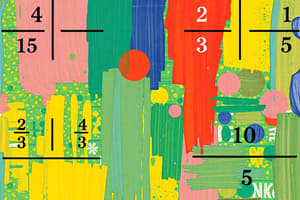Podcast
Questions and Answers
Which of the following fractions is an improper fraction?
Which of the following fractions is an improper fraction?
- $ rac{5}{9}$
- $ rac{11}{6}$ (correct)
- $ rac{2}{5}$
- $ rac{3}{7}$
Which symbol correctly compares the two fractions $\frac{3}{5}$ and $\frac{4}{7}$?
Which symbol correctly compares the two fractions $\frac{3}{5}$ and $\frac{4}{7}$?
- $>$ (correct)
- $<$
- $=$
- None of the above
Which of the following pairs of fractions are equal?
Which of the following pairs of fractions are equal?
- $\frac{1}{2}$ and $\frac{2}{5}$
- $\frac{4}{5}$ and $\frac{5}{6}$
- $\frac{2}{3}$ and $\frac{3}{4}$
- $\frac{3}{6}$ and $\frac{1}{2}$ (correct)
Arrange the following fractions in ascending order: $\frac{2}{5}$, $\frac{1}{3}$, $\frac{3}{4}$
Arrange the following fractions in ascending order: $\frac{2}{5}$, $\frac{1}{3}$, $\frac{3}{4}$
Identify the proper fraction among the following options.
Identify the proper fraction among the following options.
Flashcards
Proper Fraction
Proper Fraction
A fraction where the numerator is less than the denominator; its value is less than 1.
Improper Fraction
Improper Fraction
A fraction where the numerator is greater than or equal to the denominator; its value is 1 or greater.
< Symbol
< Symbol
Symbol used to indicate that the value on the left is less than the value on the right.
Symbol
Symbol
Signup and view all the flashcards
= Symbol
= Symbol
Signup and view all the flashcards
Study Notes
- A fraction represents a part of a whole or, more generally, any number of equal parts
- It is written as a ratio of two numbers: numerator and denominator
- Numerator is the number of parts we are considering
- Denominator is the total number of parts the whole is divided into
Proper Fraction
- A proper fraction is a fraction where the numerator (the top number) is less than the denominator (the bottom number)
- This means the value of the fraction is less than 1
- Examples of proper fractions: 1/2, 3/4, 2/5, 7/10, 15/16
- In each case, the numerator is smaller than the denominator
Improper Fraction
- An improper fraction is a fraction where the numerator is greater than or equal to the denominator
- This means the value of the fraction is greater than or equal to 1
- Examples of improper fractions: 5/3, 7/2, 4/4, 11/4, 8/5
- When the numerator equals the denominator, the fraction is equal to 1 (e.g. 4/4 = 1)
Mixed Number
- A mixed number is a whole number combined with a proper fraction
- It represents the sum of the whole number and the fraction
- Examples of mixed numbers: 1 1/2, 2 3/4, 5 1/3
- Improper fractions can be converted into mixed numbers
- To convert an improper fraction to a mixed number, divide the numerator by the denominator
- The quotient is the whole number part, the remainder is the numerator of the fractional part, and the denominator stays the same
- Example: 7/3 = 2 1/3 (7 divided by 3 is 2 with a remainder of 1)
- To convert a mixed number to an improper fraction, multiply the whole number by the denominator and add the numerator
- Put the result over the original denominator
- Example: 2 1/3 = (2*3 + 1)/3 = 7/3
Comparing Fractions
- To compare fractions, we determine which fraction is larger, smaller, or if they are equal
- Symbols used for comparison:
- '<' means "less than"
- '>' means "greater than"
- '=' means "equal to"
Comparing Fractions with the Same Denominator
- When fractions have the same denominator, the fraction with the larger numerator is the larger fraction
- Example: 3/5 and 2/5
- Since 3 > 2, then 3/5 > 2/5
Comparing Fractions with the Same Numerator
- When fractions have the same numerator, the fraction with the smaller denominator is the larger fraction
- Example: 3/4 and 3/5
- Since 4 < 5, then 3/4 > 3/5
- This is because if you divide something into fewer parts (smaller denominator), each part is larger
Comparing Fractions with Different Numerators and Denominators
- To compare fractions with different numerators and denominators, a common denominator must be found
- This involves finding the least common multiple (LCM) of the denominators
- Once a common denominator is found, rewrite each fraction with the common denominator
- Then, compare the numerators as in the "same denominator" case
- Example: Compare 2/3 and 3/4
- The least common multiple of 3 and 4 is 12
- Rewrite 2/3 as 8/12 (multiply numerator and denominator by 4)
- Rewrite 3/4 as 9/12 (multiply numerator and denominator by 3)
- Since 8 < 9, then 8/12 < 9/12, so 2/3 < 3/4
Comparing Fractions to 1/2
- This is a useful shortcut for quick comparisons
- If the numerator is more than half of the denominator, the fraction is greater than 1/2
- If the numerator is less than half of the denominator, the fraction is less than 1/2
- If the numerator is equal to half of the denominator, the fraction is equal to 1/2
- Examples:
- 3/5: Half of 5 is 2.5, and 3 > 2.5, so 3/5 > 1/2
- 2/7: Half of 7 is 3.5, and 2 < 3.5, so 2/7 < 1/2
- 4/8: Half of 8 is 4, and 4 = 4, so 4/8 = 1/2
Using the Cross-Multiplication Method
- An alternate method to compare fractions a/b and c/d
- Multiply the numerator of the first fraction by the denominator of the second fraction (a * d)
- Multiply the numerator of the second fraction by the denominator of the first fraction (b * c)
- Compare the results:
- If a * d > b * c, then a/b > c/d
- If a * d < b * c, then a/b < c/d
- If a * d = b * c, then a/b = c/d
- Example: Compare 2/3 and 3/4
- 2 * 4 = 8
- 3 * 3 = 9
- Since 8 < 9, then 2/3 < 3/4
Examples of Comparing Fractions with Symbols
- 1/4 < 1/2 (Because 1/4 is less than 1/2)
- 3/5 > 1/3 (Because 3/5 is greater than 1/3)
- 2/4 = 1/2 (Because 2/4 is equal to 1/2)
- 5/8 > 1/2 (Because 5/8 is greater than 1/2)
- 7/10 > 2/5 (Convert 2/5 to 4/10. Since 7/10 > 4/10)
- 3/7 < 1/2 (Because 3 is less than half of 7 which is 3.5)
- 5/5 = 1 (Because when the numerator and denominator are the same, the fraction equals 1)
- 6/4 > 1 (Because 6/4 is an improper fraction where the numerator is greater than the denominator)
Studying That Suits You
Use AI to generate personalized quizzes and flashcards to suit your learning preferences.




